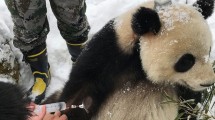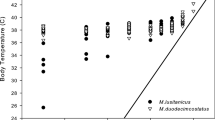Summary
Two primarily granivorous rodents of Old World deserts,Gerbillus allenbyi (mean adult body mass=26 g) andG. pyramidum (mean adult body mass=40 g), coexist in sandy habitats in the northwestern Negev desert. Both species are burrow dwellers and are nocturnal; however, in their overall distributions,G. pyramidum occurs in more extreme deserts than doesG. allenbyi. In comparing field metabolic rate (FMR) and water influx of the twoGerbillus species, we considered two alternative hypotheses: (1) given the difference in their overall distributions,G. pyramidum has a lower FMR and water influx thanG. allenbyi, and (2) given the similarity in their diets, and that we worked with sympatric populations, FMR and water influx are similar. The latter alternative proved to be correct. Field metabolic rates in summer were 7.29 kJ · g-0.51 · day-1 forG. allenbyi and 7.74 kJ · g-0.51 · day-1 forG. pyramidum, values that were 69.3% and 74.5%, respectively, of those predicted for rodents of their body masses. Summer water influx ofG. allenbyi was 0.167 ml · g-0.90 · day-1 and that ofG. pyramidum was 0.144 ml · g-0.90 · day-1; these values were 79.4% and 68.6%, respectively, of water influxes predicted for rodents of their body masses. When compared allometrically, there were no interspecific differences in any of the measurements.
Similar content being viewed by others
References
Abramsky Z (1983) Experiments on seed predation by rodents and ants in the Israeli desert. Oecologia 57:328–332
Abramsky Z, Pinshow B (1989) Changes in foraging effort in two gerbil species correlate with habitat type and intra-and interspecific activity. Oikos 56:43–53
Abramsky Z, Brand S, Rosenzweig ML (1985) Geographical ecology of gerbilline rodents in sand dune habitats of Israel. J Biogeogr 12:363–372
Bar Y, Abramsky Z, Gutterman Y (1984) Diets of gerbillinae rodents in the Israeli desert. J Arid Environ 7:371–376
Culebras JM, Fitzpatrick GF, Brennan MF, Boyen CM, Moore FD (1977) Total body water and exchangeable hydrogen. II. A review of comparative data from animals based on isotope dilution and desiccation, with a report of new data from the rat. Am J Physiol 232:R60-R65
Danin A (1978) Plant species diversity and plant succession in a sandy area in the northern Negev. Flora 167:409–422
Degen AA, Kam M (1991) Average daily metabolic rate of gerbils of two species:Gerbillus pyramidum andGerbillus allenbyi. J Zool 223:143–149
Degen AA, Pinshow B, Alkon PU, Arnon H (1981) Tritiated water for estimating total body water and water turnover rate in birds. J Appl Physiol 51:1183–1188
Degen AA, Kam M, Hazan A, Nagy KA (1986) Energy expenditure and water flux in three sympatric desert rodents. J Anim Ecol 55:421–429
Degen AA, Kam M, Jurgrau D (1988) Energy requirements of fat sand rats (Psammomys obesus) and their efficiency of utilization of the saltbushAtriplex halimus for maintenance. J Zool 215:443–452
Degen AA, Hazan A, Kam M, Nagy KA (1991) Seasonal water influx and energy expenditure of free-living fat sand rats. J Mammal 72:652–657
Downs CT, Perrin MR (1990) Field water-turnover rates of threeGerbillurus species. J Arid Environ 19:199–208
Evenari M, Shanan L, Tadmor N (1982) The Negev: the challenge of a desert. Harvard University Press, Cambridge, Mass
Gettinger RD (1983) Use of doubly-labelled water (3HH18O) for determination of H2O flux and CO2 production by a mammal in a humid environment. Oecologia 59:54–57
Gettinger RD (1984) Energy and water metabolism of free-ranging pocket gophers,Thomomys bottae. Ecology 65:740–751
Happold DCD (1984) Small animals. In: Cloudsley-Thompson JL (ed) Sahara Desert. Permagon Press, London, pp 251–257
Hulbert AJ, Hinds DS, MacMillen RE (1985) Minimal metabolism, summit metabolism and plasma thyroxin in rodents from different environments. Comp Biochem Physiol [A] 81:687–693
Kam M, Degen AA, Nagy KA (1987) Seasonal energy, water, and food consumption of Negev chukars and sand partridges. Ecology 68:1029–1037
Karasov WH (1981) Daily energy expenditure and the cost of activity in a free-living mammal. Oecologia 51:253–259
Karasov WH (1983) Water flux and water requirements in free-living antelope ground squirrelsAmmospermophilus leucurus. Physiol Zool 56:94–105
Kenagy GJ (1972) Saltbush leaves: excision of hypersaline tissue by a kangaroo rat. Science 178:1094–1096
kenagy GJ (1973) Adaptation for leaf eating in the Great Basin kangaroo rat,Dipodomys microps. Oecologia 12:383–412
Kleiber M (1975) The fire of life, Krieger, New York
Lifson N, McClintock R (1966) Theory of use of the turnover rates of body water for measuring energy and material balance. J Theor Biol 12:46–74
Linder Y (1988) Seasonal changes in thermoregulation in two Gerbil species,Gerbillus pyramidum andGerbillus allenbyi, and their contribution to energy balance. M.Sc. thesis, Ben-Gurion University of the Negev, Beer-Sheva (in Hebrew with English abstract)
McNab BK (1979) Climatic adaptation in the energetics of heteromyid rodents. Comp Biochem Physiol [A] 62:813–820
McNab BK (1986) The influence of food habits on the energetics of eutherian mammals. Ecol Monogr 56:1–19
Mendelssohn H, Tom-Tov Y (1987) Plants and animals of the land of Israel, vol. 7. Mammals. Ministry of Defense, The Publishing House, Israel
Morris KD, Bradshaw SD (1981) Water and sodium turnover in coastal and inland populations of the ash-grey mouse,Pseudomys albocinereus (Gould), in Western Australia. Aust J Zool 29:519–533
Morton SR, MacMillen RE (1982) Seeds as source of preformed water for desert-dwelling granivores. J Arid Environ 5:61–67
Mullen RK (1970) Respiratory metabolism and body water turnover rates ofPerognathus formosus in its natural environment. Comp Biochem Physiol [A] 32:259–265
Mullen RK (1971) Energy metabolism and body water turnover rates of two species of free-living kangaroo rats,Dipodomys merriami andDipodomys microps. Comp Biochem Physiol [A] 39:379–390
nagy KA (1980) CO2 production in animals: analysis of potential errors in the doubly labelled water method. Am J Physiol 238:R466-R473
Nagy KA (1983) The doubly labelled water (3HH18O) method: a guide to its use. UCLA Publication No. 12-1417
Nagy KA (1987) Field metabolic rate and food requirement scaling in mammals and birds. Ecol Monogr 57:111–128
Nagy KA, Costa DP (1980) Water flux in animals: analysis of potential errors in the tritiated water method. Am J Physiol 338:R454-R465
Nagy KA, Milton K (1979) Energy metabolism and food consumption by wild howler monkeys (Alouatta palliata). Ecology 60:475–480
Nagy KA, Peterson CC (1988) Scaling of water flux rate in animals. Univ Calif Publ Zool 120:1–172
Osborn DJ, Helmy I (1980) Fieldiana zoology, new series No. 5. The contemporary land mammals of Egypt (including Sinai). Field Museum of Natural History, Chicago, Ill
Stern E, Gradus Y, Meir A, Krakover S, Tsoar H (1986) Atlas of the Negev. Keterpress, Jerusalem, Israel
Wood RA, Nagy K, MacDonald NS, Wakakuwa ST, Beckman RJ, Kaaz H (1975). Determination of oxygen-18 in water contained in biological samples by charged particle activation. Anal Chem 47:646–650
Author information
Authors and Affiliations
Rights and permissions
About this article
Cite this article
Degen, A.A., Pinshow, B. & Kam, M. Field metabolic rates and water influxes of two sympatric Gerbillidae:Gerbillus allenbyi andG. pyramidum . Oecologia 90, 586–590 (1992). https://doi.org/10.1007/BF01875454
Received:
Accepted:
Issue Date:
DOI: https://doi.org/10.1007/BF01875454




